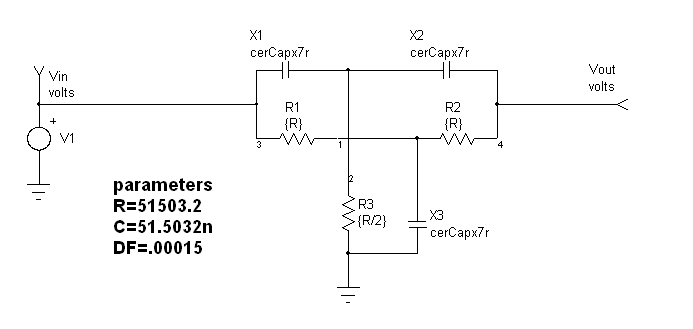
- PARALLEL NOTCH FILTER DESIGNER HOW TO
- PARALLEL NOTCH FILTER DESIGNER SERIES
- PARALLEL NOTCH FILTER DESIGNER TV
We use a reactance calculator to determine an inductance that has a 390.6 Ω reactance at 14MHzĪs you can see, the filter’s frequency response is a low pass with a resonant peak at 14MHz, the resonant peak is caused by the filter having a high Q if the Q was lower, the filter would be lowpass without a peak. We use a reactance calculator to determine an inductance that has a 384.1 Ω reactance at 14MHz Since our source resistance is larger than the load resistance, we will use the “b” filterįirst, we need to calculate the reactance’s of the two components of an L filter, then we can calculate the inductance and capacitance based on reactance and frequency of use: To calculate the values of L filter components, we need three things: output resistance of the source, resistance of the load, and the frequency of operation.įor example, the output resistance of the source will be 3000 Ω, load resistance will be 50 Ω, and the frequency is 14 MHz. If we wanted more or less filtering (different Q), we would need the PI filter, where Q is fully adjustable and you can have different L and C combinations that can give you the required matching at a given frequency, each with a different Q. Where R A is the bigger impedance, RL is the smaller impedance, and Q is the Q factor with the appropriate load connected.


Their Q factor, and therefore how good the filter is equal to In every L filter, there is only one combination of L and C that can match a given input impedance to given output impedance.įor example, to match a 50 Ω load to a 100 Ω load at 14MHz, we need a 560nH inductor with a 114pF capacitor – this is the only combination that can do matching at this frequency with these resistances. They can be used to match impedance that is higher or lower than the source impedance. They consist of a capacitor and an inductor, connected in a way similar to that found in RC filters, with the inductor replacing the resistor. L filters are the simplest form of LC filters. A High Q factor sometimes reduces efficiency.

A high Q filter will filter out undesired frequencies, but it will have a resonant peak, so it will also act as a bandpass filter. A low Q filter will be very broadband and will not filter out undesired frequencies as good as a high Q filter. output/input impedance = resistance.Įvery LC filter has a parameter known as a Q (quality) factor, in the low pass and high pass filters it determines the steepness of the frequency response.
PARALLEL NOTCH FILTER DESIGNER TV
In most cases, such as integrated circuits, properly made and tuned antennas, TV and radio receivers, transmitters, etc. In this case, it is best to use a PI filter or L filter calculator.
PARALLEL NOTCH FILTER DESIGNER SERIES
When designing LC filters, we will talk about source resistance and load resistance instead of impedance, because if the load or source has some series or parallel inductance or capacitance, and therefore non-resistive impedance the calculations get much more complex.

We will cover low-pass LC filters because radio power amplifiers only generate harmonics, and harmonic signals are always the whole multiple of the base signals, so they always have higher frequencies than the base signal – this is why we use low-pass filters, they let the wanted signal through while getting rid of harmonics. Filtering is especially important on the output of power RF amplifiers because they generate a lot of unwanted harmonics that have to be filtered before they are transmitted by the antenna because they can cause interference and transmitting on frequencies other than the ones the station is approved to transmit on can be illegal. Various LC filters can be used to match impedances and provide filtering. There are many types of filter circuits that can be used in for Impedance matching, the most common ones are discussed in this article. Apart from using an impedance matching transformer, designers can also use Impedance Filter circuits at the output of an RF amplifier which can double up as a filtering circuit and also as an impedance matching circuit.
PARALLEL NOTCH FILTER DESIGNER HOW TO
In the previous article, we discussed the basics of impedance matching and how to use an impedance matching transformer.


 0 kommentar(er)
0 kommentar(er)
